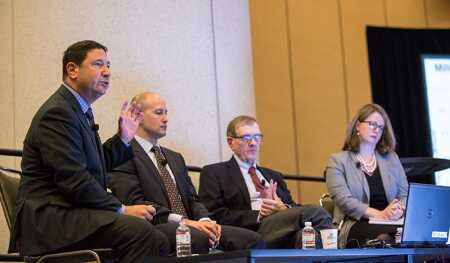Demographics exert a great influence on real estate, and a panel of experts at ULI’s Fall Meeting examined major population trends—and some myths about them, such as the notions that members of the millennial generation are not interested in owning their own homes and people are losing interest in suburban life.
William H. Frey, a senior fellow at the Brookings Institution, cited well-publicized U.S. Census Bureau forecasts that by 2044, racial minorities, taken together, will become the majority in the U.S. population. What people do not understand, Frey said, is how rapidly that shift is unfolding.
Thanks in part to immigration that occurred over the past 25 years, rapid population growth is taking place among what he called “new minorities,” including Hispanics, Asians, and people who claim multiple races. This growth is “happening just in time,” he said, to offset an expected decline in the number of whites. In about ten years, Frey said, deaths will outnumber births among the white population, which will shrink the size of this demographic segment. This shrinkage is already happening to the white population under age 30, he noted.
Not only will a diverse group of new immigrants offset that decline, but these immigrants are spreading their influence geographically. There is a huge dispersion of Hispanic and Asian immigrants from traditional “melting pot” cities such as Los Angeles, Miami, and New York City to the rest of the United States, Frey said. In particular, he noted the rapid growth of the Hispanic population in high-growth metro areas such as Atlanta and Charlotte, North Carolina—and in slow-growing metro areas such as Omaha, Nebraska, and Scranton, Pennsylvania. In slow-growing metro areas such as the latter two, there would be no population growth except for this influx.
Another significant population shift under way is of African Americans moving back to the south. “Atlanta is the main magnet for blacks in the South,” Frey said. For the most part, they are moving to the suburbs, not downtown, he added.
Demand for suburban living remains strong among many demographic groups, said Michelle McDonough Winters, a ULI senior visiting fellow. “The baby boomers really like rural living and small towns,” she said, citing America in 2015, a report ULI issued earlier this year. She noted that a high percentage of people among all age groups say they want to live in a community with a mix of ages.
Economist Jed Kolko, who for years was chief economist at online real estate company Trulia, told those in attendance that there are now more people among the U.S. population age 24 than any other age—and that age is young, even by pre-recessionary standards, for people to be buying a home. Therefore, he says, it is not surprising that homebuying by millennials is low. The homeownership rate among young adults today is about the same as it was 20 years ago, he noted.
However, he said that despite a significant economic recovery, the number of people age 18 to 30 still living in their parents’ homes remains as high as it was during the recession. “Frankly, I am surprised that we have not seen that come down yet,” he said, questioning whether this might become the “new normal.”
John T. Chang, first vice president for research services at Marcus & Millichap, said he expects that as millennials begin to form households, homeownership rates will move back toward long-term averages.
Kolko said the “dramatic urban rebound,” in which people flocked to cities after the housing bubble burst, was a temporary phenomenon. Suburbs and exurbs are now growing faster than cities, he said, noting that 2011 was the “brief moment” when cities grew faster than the suburbs. He also disputed the idea that dense, walkable suburbs are growing fastest now. In truth, he says, the fastest growth is in lower-density suburbs, despite the intense popularity of some high-profile urban/suburban areas such as Brooklyn, New York.
The second-largest peak in the population now is those age 55, Kolko said. The growth in the number of seniors, age 65 and older, will be huge, he said. Their numbers will increase by more than one-third over the next ten years—a rise that will boost demand for suburban living.


